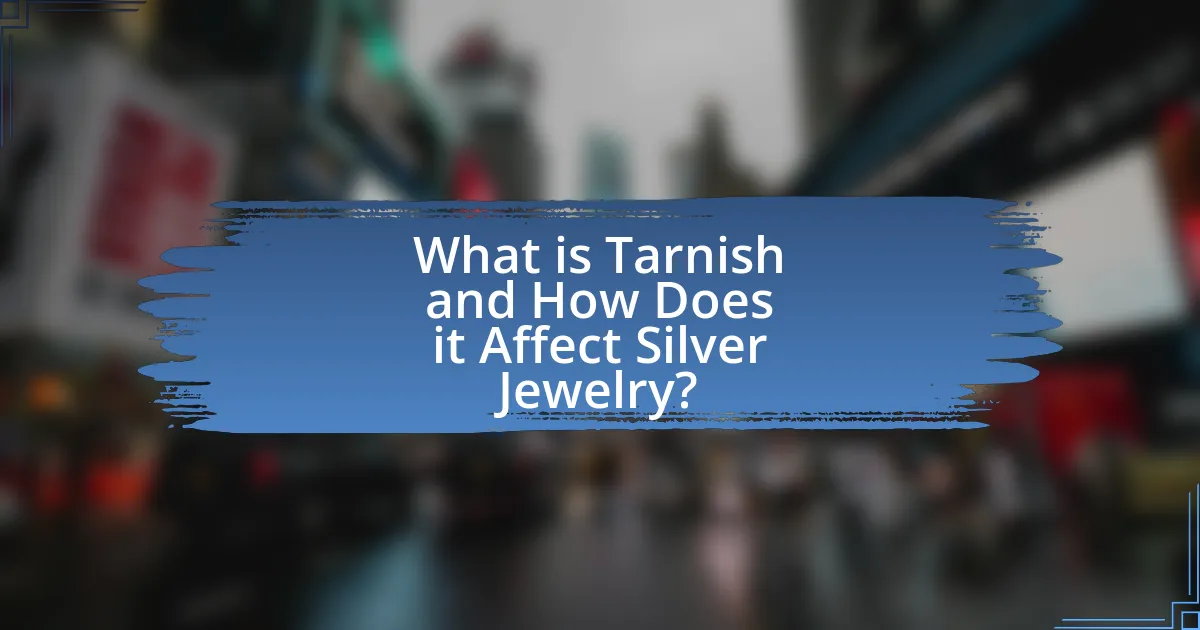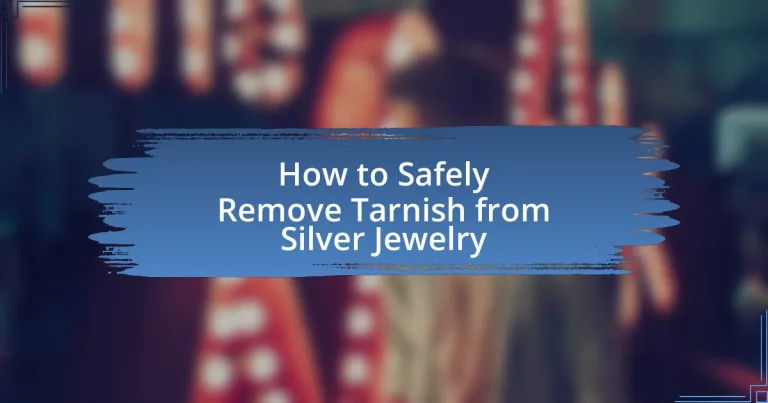Tarnish is a chemical reaction that affects silver jewelry, primarily caused by exposure to sulfur compounds in the air, leading to the formation of silver sulfide. This article explores the causes of tarnish, including environmental factors and oxidation, and emphasizes the importance of removing tarnish to maintain the jewelry’s aesthetic appeal and structural integrity. It outlines safe methods for tarnish removal using household items and commercial products, while also providing precautions to prevent damage during the cleaning process. Additionally, the article offers best practices for maintaining silver jewelry to prevent future tarnishing.

What is Tarnish and How Does it Affect Silver Jewelry?
Tarnish is a chemical reaction that occurs when silver jewelry reacts with sulfur compounds in the air, leading to the formation of silver sulfide on its surface. This reaction not only dulls the shine of the silver but can also cause discoloration and, if left untreated, may lead to more significant damage over time. The presence of tarnish can diminish the aesthetic appeal of silver jewelry, making it appear old or neglected. Regular cleaning and proper storage can help mitigate tarnish formation and maintain the jewelry’s appearance.
What causes tarnish on silver jewelry?
Tarnish on silver jewelry is primarily caused by a chemical reaction between silver and sulfur-containing substances in the air or on the skin. This reaction leads to the formation of silver sulfide, which appears as a dark discoloration on the surface of the jewelry. Factors such as humidity, exposure to certain chemicals, and the presence of skin oils can accelerate this tarnishing process. Studies have shown that even low levels of sulfur compounds in the environment can significantly contribute to tarnishing, making it a common issue for silver items.
How do environmental factors contribute to tarnishing?
Environmental factors contribute to tarnishing primarily through exposure to moisture, sulfur compounds, and pollutants. High humidity levels can accelerate the oxidation process, leading to the formation of tarnish on silver surfaces. Sulfur, commonly found in the air from sources like industrial emissions and certain foods, reacts with silver to create silver sulfide, which appears as tarnish. Additionally, exposure to household chemicals, such as those found in cleaning products, can also promote tarnishing. Studies indicate that environments with higher levels of air pollution can increase the rate of tarnishing on silver items, demonstrating a direct correlation between environmental conditions and the deterioration of silver’s appearance.
What role does oxidation play in tarnishing silver?
Oxidation plays a crucial role in tarnishing silver by causing a chemical reaction between silver and sulfur compounds in the air, leading to the formation of silver sulfide. This reaction occurs when silver is exposed to moisture and pollutants, resulting in a darkened appearance on the surface of the metal. The process of oxidation is evidenced by the fact that tarnish can develop more rapidly in environments with higher levels of sulfur, such as near rubber, certain foods, or polluted air.
Why is it important to remove tarnish from silver jewelry?
Removing tarnish from silver jewelry is important to maintain its aesthetic appeal and prevent long-term damage. Tarnish, which is primarily caused by the reaction of silver with sulfur compounds in the air, can lead to discoloration and a dull appearance. If left untreated, tarnish can become more difficult to remove and may even cause pitting or corrosion on the surface of the silver. Regular cleaning helps preserve the jewelry’s shine and value, ensuring it remains visually appealing and in good condition for years.
How does tarnish impact the appearance of silver jewelry?
Tarnish significantly alters the appearance of silver jewelry by creating a dull, discolored layer on the surface. This layer, primarily composed of silver sulfide, forms when silver reacts with sulfur compounds in the air or from skin contact. As tarnish accumulates, it obscures the shiny, reflective quality that is characteristic of polished silver, leading to a less appealing aesthetic. The presence of tarnish can diminish the overall value and desirability of the jewelry, as it may appear neglected or of lower quality.
What are the potential long-term effects of leaving tarnish untreated?
Leaving tarnish untreated can lead to irreversible damage to silver jewelry. Over time, tarnish, which is primarily composed of silver sulfide, can cause pitting and corrosion on the surface of the metal. This deterioration not only affects the aesthetic appeal of the jewelry but can also weaken its structural integrity, making it more susceptible to breakage. Studies have shown that prolonged exposure to tarnish can result in significant loss of silver material, as the corrosion process continues to degrade the metal. Therefore, timely removal of tarnish is essential to preserve both the appearance and longevity of silver jewelry.

What are the Safe Methods for Removing Tarnish from Silver Jewelry?
The safe methods for removing tarnish from silver jewelry include using a mixture of baking soda and water, applying a silver polish specifically designed for jewelry, and utilizing a gentle soap solution. Baking soda creates a mild abrasive that effectively lifts tarnish without scratching the silver, while silver polish contains chemicals that safely restore shine. A gentle soap solution, made with warm water and a few drops of dish soap, can clean silver without causing damage. These methods are widely recommended by jewelers and are effective in maintaining the integrity of silver jewelry.
How can household items be used to remove tarnish safely?
Household items such as baking soda, vinegar, and aluminum foil can be used to safely remove tarnish from silver jewelry. Baking soda mixed with water creates a paste that can be applied to tarnished areas, effectively lifting the tarnish without scratching the silver. Vinegar, when combined with baking soda, can also create a chemical reaction that helps dissolve tarnish. Additionally, placing tarnished silver in a bowl lined with aluminum foil and adding boiling water mixed with baking soda allows the tarnish to transfer from the silver to the foil, utilizing an electrochemical reaction. These methods are safe and effective, as they avoid harsh chemicals that could damage the silver.
What common kitchen ingredients are effective for tarnish removal?
Common kitchen ingredients effective for tarnish removal include baking soda, vinegar, and lemon juice. Baking soda acts as a mild abrasive that can lift tarnish when mixed with water to form a paste. Vinegar, when combined with baking soda, creates a chemical reaction that helps dissolve tarnish. Lemon juice contains citric acid, which can effectively break down tarnish on silver surfaces. These ingredients are widely recognized for their cleaning properties and are often recommended for safe tarnish removal from silver jewelry.
How do these household methods compare in effectiveness?
Household methods for removing tarnish from silver jewelry, such as baking soda paste, vinegar and baking soda solution, and aluminum foil with baking soda, vary in effectiveness. Baking soda paste is effective for light tarnish and is non-abrasive, while vinegar and baking soda can tackle moderate tarnish but may require more scrubbing. The aluminum foil method is particularly effective for heavy tarnish due to its chemical reaction that accelerates the removal process. Studies indicate that the aluminum foil method can restore tarnished silver to its original shine more efficiently than the other methods, making it a preferred choice for significant tarnish removal.
What commercial products are available for tarnish removal?
Commercial products available for tarnish removal include silver polish, tarnish wipes, and ultrasonic cleaners. Silver polish, such as Wright’s Silver Cream and Hagerty Silver Polish, effectively removes tarnish while providing a protective layer. Tarnish wipes, like the Sunshine Cloth and Goddard’s Silver Wadding, offer convenient, quick cleaning options. Ultrasonic cleaners, such as the Magnasonic Professional Ultrasonic Jewelry Cleaner, use high-frequency sound waves to remove tarnish from intricate designs without damaging the silver. These products are widely recognized for their effectiveness in restoring the shine of silver jewelry.
What should you look for in a commercial tarnish remover?
When selecting a commercial tarnish remover, look for a product that is specifically formulated for silver, as it ensures compatibility and effectiveness. Effective tarnish removers often contain ingredients like ammonium hydroxide or citric acid, which are known to effectively dissolve tarnish without damaging the silver. Additionally, consider products that are non-abrasive and safe for frequent use, as these will help maintain the integrity of the jewelry over time. Always check for user reviews and product ratings to validate the effectiveness and safety of the tarnish remover, as consumer feedback can provide insights into real-world performance.
How do you safely use these commercial products on silver jewelry?
To safely use commercial products on silver jewelry, first read the manufacturer’s instructions carefully to ensure compatibility with silver. Many commercial tarnish removers contain chemicals that can damage silver if not used correctly. Apply the product using a soft cloth or sponge, avoiding abrasive materials that can scratch the surface. Rinse the jewelry thoroughly with water after treatment to remove any residue, as leftover chemicals can lead to further tarnishing. Always test the product on a small, inconspicuous area of the jewelry first to check for adverse reactions.

What Precautions Should Be Taken When Removing Tarnish?
When removing tarnish from silver jewelry, it is essential to take precautions to avoid damage. First, always test a small, inconspicuous area of the jewelry before applying any cleaning solution to ensure it does not react negatively. Additionally, use non-abrasive materials, such as soft cloths or sponges, to prevent scratching the surface. It is also important to avoid harsh chemicals, as they can corrode the silver; instead, opt for gentle, silver-safe cleaners. Finally, ensure that the jewelry is completely dry before storing it to prevent future tarnishing. These precautions help maintain the integrity and appearance of silver jewelry during the cleaning process.
How can you protect your silver jewelry during the cleaning process?
To protect your silver jewelry during the cleaning process, use a soft cloth to gently wipe the surface before cleaning. This action removes dust and debris that could scratch the silver. Additionally, avoid using abrasive cleaners or materials, as they can damage the finish. Instead, opt for a mild soap solution and a soft brush for cleaning. It is also advisable to soak the jewelry briefly rather than scrubbing it, which minimizes wear. Finally, ensure that the jewelry is completely dry before storing it to prevent moisture-related tarnishing. These methods are effective in maintaining the integrity and appearance of silver jewelry during cleaning.
What tools should be avoided to prevent damage to silver?
To prevent damage to silver, avoid using abrasive materials such as steel wool, scouring pads, or harsh chemical cleaners. These tools can scratch the surface of silver and lead to permanent damage. Additionally, avoid using ultrasonic cleaners, as they can cause structural issues in delicate silver pieces. The use of these tools is widely recognized in silver care guidelines, emphasizing the importance of gentle cleaning methods to maintain the integrity of silver items.
How can you test a cleaning method on a small area first?
To test a cleaning method on a small area first, select an inconspicuous spot on the silver jewelry and apply the cleaning solution using a soft cloth or cotton swab. This approach allows you to observe any adverse reactions, such as discoloration or damage, before applying the method to the entire piece. Testing in a hidden area minimizes the risk of visible harm to the jewelry, ensuring that the cleaning method is safe and effective for the entire item.
What are the best practices for maintaining silver jewelry after cleaning?
To maintain silver jewelry after cleaning, store it in a cool, dry place, ideally in anti-tarnish pouches or cloths to prevent oxidation. Regularly wear the jewelry, as the natural oils from skin can help keep it shiny. Additionally, avoid exposing silver to harsh chemicals, such as those found in household cleaners or perfumes, which can cause tarnishing. These practices are supported by the fact that silver tarnishes due to reactions with sulfur compounds in the air, and proper storage significantly reduces exposure to these elements.
How can you prevent future tarnishing of silver jewelry?
To prevent future tarnishing of silver jewelry, store it in a cool, dry place, ideally in anti-tarnish pouches or cloths. Silver tarnishes due to exposure to moisture, sulfur, and air, so minimizing these factors is essential. Using silica gel packets in storage containers can absorb moisture, while anti-tarnish products contain chemicals that inhibit tarnish formation. Regularly cleaning silver jewelry with a soft cloth after wearing it also helps remove oils and dirt that can accelerate tarnishing.
What storage tips help keep silver jewelry tarnish-free?
To keep silver jewelry tarnish-free, store it in a cool, dry place, ideally in anti-tarnish pouches or cloths. These materials contain chemicals that absorb moisture and prevent oxidation, which is the primary cause of tarnish. Additionally, placing silica gel packets in the storage container can further reduce humidity levels, minimizing tarnish formation. Regularly cleaning silver jewelry with a soft cloth before storage also helps remove any oils or residues that can accelerate tarnishing.
What are the common mistakes to avoid when removing tarnish from silver jewelry?
Common mistakes to avoid when removing tarnish from silver jewelry include using abrasive materials, which can scratch the surface, and applying harsh chemicals that may damage the metal. Additionally, neglecting to test cleaning solutions on a small, inconspicuous area first can lead to irreversible damage. Using excessive force while polishing can also result in bending or breaking delicate pieces. Lastly, failing to dry the jewelry properly after cleaning can lead to further tarnishing. These practices are well-documented in jewelry care guidelines, emphasizing the importance of gentle handling and appropriate cleaning methods.


